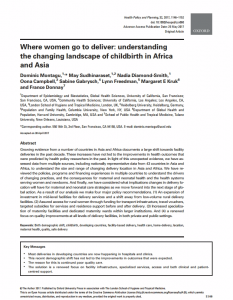
Growing evidence from a number of countries in Asia and Africa documents a large shift towards facility deliveries in the past decade. These increases have not led to the improvements in health outcomes that were predicted by health policy researchers in the past. In light of this unexpected evidence, we have assessed data from multiple sources, including nationally representative data from 43 countries in Asia and Africa, to understand the size and range of changing delivery location in Asia and Africa. We have reviewed the policies, programs and financing experiences in multiple countries to understand the drivers of changing practices, and the consequences for maternal and neonatal health and the health systems serving women and newborns. And finally, we have considered what implications changes in delivery location will have for maternal and neonatal care strategies as we move forward into the next stage of global action. As a result of our analysis we make four major policy recommendations. (1) An expansion of investment in mid-level facilities for delivery services and a shift away from low-volume rural delivery facilities. (2) Assured access for rural women through funding for transport infrastructure, travel vouchers, targeted subsidies for services and residence support before and after delivery. (3) Increased specialization of maternity facilities and dedicated maternity wards within larger institutions. And (4) a renewed focus on quality improvements at all levels of delivery facilities, in both private and public settings.